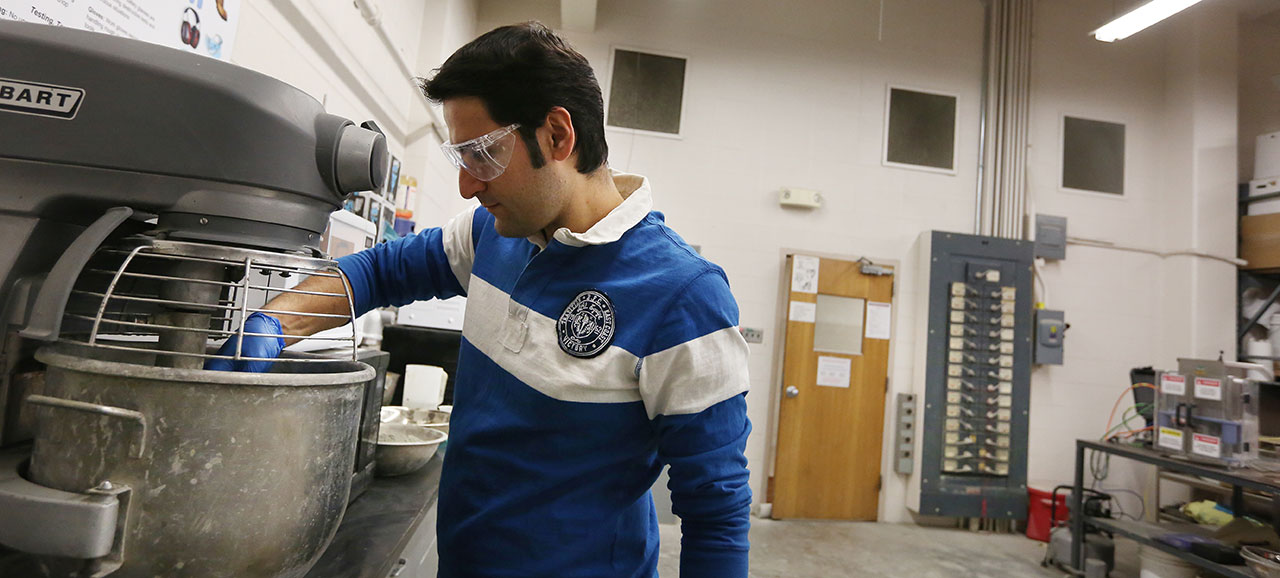Concrete, reimagined
Posted by Mary Helen Stoltz

A student works in the Center for Infrastructure Engineering Studies. Sam O’Keefe/Missouri S&T
D+. That’s the barely passing cumulative grade the American Society of Civil Engineers gave U.S. infrastructure in its 2013 Report Card. A full national economic recovery will require serious infrastructure rehabilitation, and Missouri S&T researchers have come up with some innovative ways to accomplish it, using environmentally sustainable approaches.
Dr. Kamal H. Khayat, the Vernon and Maralee Jones Professor of Civil Engineering and director of Missouri S&T’s Center for Infrastructure Engineering Studies, is leading a team of investigators in the Advanced Materials for Sustainable Infrastructure signature area. They’re working to make high-performance, environmentally friendly construction materials to improve the nation’s deteriorating infrastructure.
Concrete typically includes four key components: Portland cement (the “glue” matrix after reaction with water), water, fine aggregate (sand) and coarse aggregate (crushed rock or gravel). But Missouri S&T researchers are adding new materials to the mixture, like recycled concrete, fly ash (the by-product of a coal plant), fibers, fillers like ground-up tires and glass, and chemical admixtures. They’re then testing how well these new mixtures perform under different environmental conditions and structural loads.
In one such project, S&T researchers are studying the behavior of high-performance concrete with adapted rheology (HPC-AR). Rheology involves flow behavior of the material that cannot be measured with traditional test methods. HPC-AR is used for the construction of bridges, airports and rail systems, port and harbor facilities, and nuclear power plants.
“Unlike conventional concrete, HPC-AR such as self-consolidating concrete requires less consolidation and uses new materials to properly fill the formwork,” says Khayat, who also serves as director of the Center for Transportation Infrastructure and Safety at Missouri S&T. “This new class of HPC can lead to quicker construction, a greater level of automation and improved productivity.”
The researchers are also investigating ultra-HPC, which has a compressive strength five to 10 times that of conventional building materials, and “eco-crete,” which contains a high volume of recycled materials.
Working with Missouri S&T’s researchers, the Missouri Department of Transportation used eco-crete with up to 40 percent recycled concrete aggregate (RCA) to build a portion of the approach to the Stan Musial Veterans Memorial Bridge in downtown St. Louis. They used RCA recovered during the renovation of Lambert-St. Louis International Airport.
MoDOT built a 22.5-foot-wide ramp in four sections: a control section made with conventional concrete and three other sections made with concrete that incorporated different levels of RCA.
Missouri S&T researchers are monitoring the eco-crete’s performance using vibrating wire strain gauges embedded in the pavement. They hope to demonstrate that this environmentally friendly concrete can perform well in the long term.
“Our main objective with eco-crete is to use at least 50 percent recycled materials, including industrial by-products, to reduce the cement content needed to make concrete. This will reduce the embodied energy and carbon footprint of concrete production,” says Khayat. “It is also an effective way to reuse waste generated from demolitions – to keep it out of landfills and conserve non-renewable natural resources.”
One of the weak links in concrete is the quality of the interface between the hydrated cement paste and aggregate. Missouri S&T researchers are investigating ways to strengthen concrete by coating coarse aggregate with materials-engineered polymers before adding them to the cement mortar.
“The polymer molecules strengthen the contact with tether groups that act like a glue, as barriers to cracking between the aggregate and matrix,” says Dr. Thomas Schuman, professor of chemistry. “Polymers have entanglement. It’s a bit like trying to remove one string of Christmas lights from a bunch – long cords with knobby protrusions.”
Schuman hopes to improve the strength of the matrix-aggregate interfaces to create tougher composite material that resists cracking, performs better structurally and has a longer service life.
“Concrete initially contains a lot of water to hydrate the matrix and bond with the aggregate,” says Schuman, but the bond can be porous and weak. “Polymers bond well to both the aggregate and the matrix and fill voids, so they can reduce the concrete’s porosity and add strength and flexibility to reduce crack initiation and propagation.”
Schuman worked with Dr. K. Chandrashekhara, Curators’ Professor of mechanical and aerospace engineering, and Dr. Jeffrey Volz, former assistant adjunct professor of civil, architectural and environmental engineering, to evaluate the engineering properties of the novel polymer-modified concrete.

I think it is great that you are spending time trying to make new concrete from 50% recycled materials. If you get it to work effectively then the environmental impacts should be huge. Besides, I would think it is also be a cheaper way of making concrete.